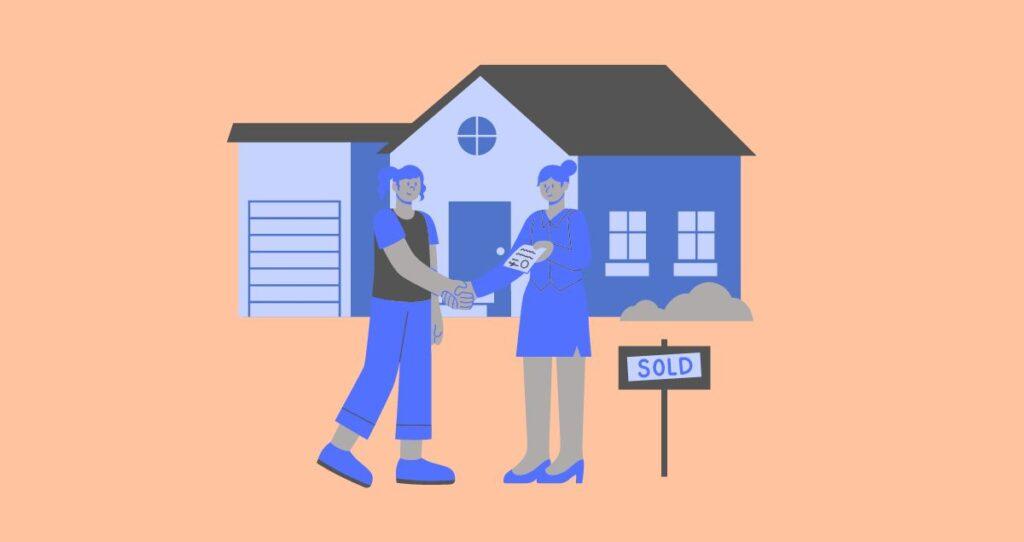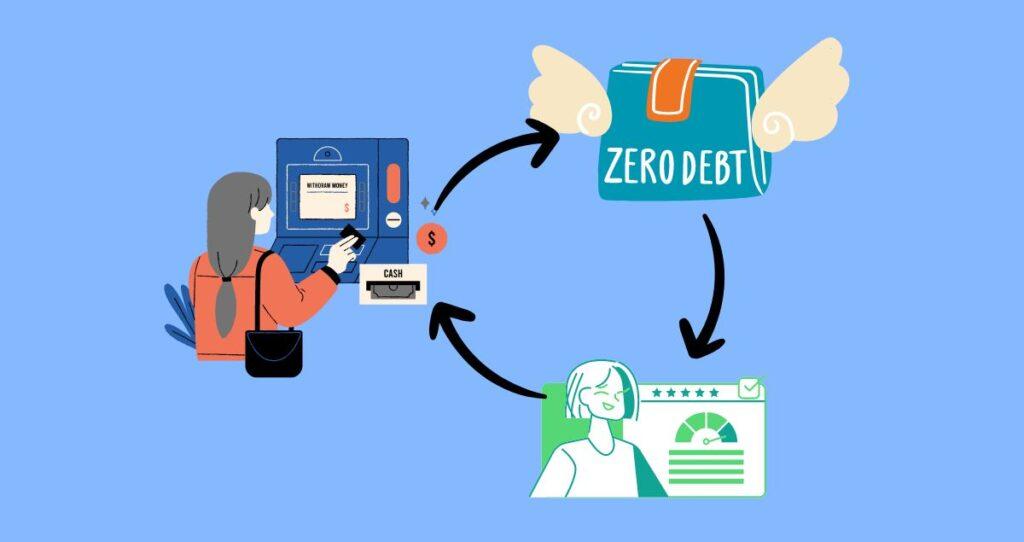Yes, you can give your house back to the bank to avoid foreclosure. Giving your house back to the bank, however, might be harder than most people think. In order for the bank to take back the house, you have to apply for the deed-in-lieu of foreclosure. This process will work only when you have exhausted all other options such as loan modifications, change of payment structure, or mortgage refinancing.
Most lenders agree to take your home back through a deed-in-lieu of foreclosure only when it is the only option left besides an actual foreclosure. The foreclosure process is very expensive and it takes a very long time to finalize. So, instead of foreclosure, your lender might agree to take your home back after you have proven that you are having serious financial hardship and there is no other way around it besides foreclosures.
This article will walk you through the process of giving your home back to your lender to avoid foreclosure, how to qualify, benefits, and drawbacks of a deed-in-lieu of foreclosure. We will also explore whether it is best for you to give your home back to the bank and how giving back your home to the bank affect your credit.
If you want voluntarily give your house back to the bank, here is all you need to know.
What is a deed-in-lieu of foreclosure?
A deed-in-lieu of foreclosure is when a homeowner who is facing foreclosure voluntarily transfers their ownership of the property back to the lender in exchange for the lender agreeing to cancel the homeowner’s debt and avoiding the foreclosure process altogether.
The homeowner must sign a deed conveying the legal ownership of the property to the lender, who will then discharge their mortgage debt. This is often a more favorable option for the homeowner than going through the foreclosure process because it can help them avoid foreclosure fees and more.
What is the difference between a deed-in-lieu and foreclosure?
The main difference between a deed-in-lieu and a foreclosure is the process by which the borrower loses the house. For a deed-in-lieu of foreclosure, a borrower voluntarily transfers the ownership of the property back to the lender. This means that a borrower must apply and qualify before this process takes place.
On the other hand, foreclosure is a process in which the lender legally takes the house after a borrower misses many mortgage payments. This process is involuntary and it is costly for both the lender and the borrower.
How does a deed-in-lieu work?
The deed-in-lieu is risky from the lender’s side besides foreclosure and bankruptcy. That is why in order to give the house back to the bank, you will first need to qualify for this process. Most lenders will consider this route only when it is the only thing left besides foreclosure. So, your job is to show your lender that there are no other options and you are ready to lose the home. Use the following tips to help you qualify for the deed-in-lieu of foreclosure.
1. Put the house on the market
When you give your house back to the bank, the bank might lose money. That is why some lenders might be hesitant to consider this route unless it is the only option left before a foreclosure. So, listing your home for sale will show that you are down for business and ready to settle your debt.
2. Make sure that you are behind in your payments
Again, in order to be approved for the deed-in-lieu, you have been facing the risk of foreclosure. The only people who face foreclosure risks are those who have fallen behind on their payments. This condition is important when you want to give the house back to the bank. You need the bank to know and think that you are falling behind on your payments and there is no way out. Otherwise, the bank will think you are doing fine.
3. Have income proofs that show financial stress
Besides falling behind on your mortgage payments, your lender will need to have proof of financial stress. That is you need to justify how your income cannot take care of your mortgage payments. Proof of income, pay stubs, and bank statements can help you seal the deal.
If you recently got laid off, also show the termination letter to further reinforce your case.
4. Submit a hardship letter
Justify why you are falling behind and can no longer afford the mortgage. Again, financial hardship will help you convince your lender that taking the house back is the best viable option moving forward. Put a hardship letter together and submit it to your mortgage servicer.
5. Make sure that there are no other liens on the home
If for example, you bought a car and used the car as collateral, your bank might not approve the application. The lender might also use the broker’s price opinion which helps determine the value of the property and financial decisions.
6. Complete the deed-in-lieu of foreclosure application
Before you can qualify for the DIL, you will need to complete the application.
7. Provide other documentation when necessary
There are times when your lender might need further details or clarification of the information you have already provided. So, be ready to work with your lender to make sure that you give them as much information as possible. If further details are necessary, provide those details. You need to be honest and truthful to increase your chances of getting your deed-in-lieu application approved.
Why did I get denied for a deed-in-lieu of foreclosure?
Although the bank might agree to take the house back, there are times when the lender will deny your requests. It is not always in the best interest of the bank to take the house. Someone somewhere loses money. So, the following are some of the reasons your bank might deny your deed-in-lieu application.
- Your home was appraised for much less than expected. In a rapidly changing market, your home might appraise much less than what the bank anticipated. In this case, the bank might not agree to take on the house.
- You have other liens on the home. If there is any other legal entity that can claim the ownership or a portion of your property, then your lender will deny your application.
- Your mortgage contract does not permit this process. Some mortgage lenders allow the deed-in-lieu processes. Others don’t. If you recently got denied, it is probable that your mortgage contract prohibits the deed-in-lieu of foreclosure.
Who qualifies for a deed-in-lieu of foreclosure?
Typically, to qualify for a deed-in-lieu of foreclosure, the homeowner must show that they have exhausted all other potential options, such as refinancing, loan modification, and making other arrangements with the lender. Additionally, it is important for the homeowner to have a legitimate hardship and be able to demonstrate that they cannot afford to keep the property and make their mortgage payments.
What should you do before deed-in-lieu of foreclosure?
Although you can give the house back to the bank to avoid foreclosure through deed-in-lieu of foreclosure; this option should be considered only after you have exercised other methods. There are less harsh methods you can use to avoid foreclosure that has less impact on your credit and credit score.
The following are some of the options to consider before pursuing the deed-in-lieu of foreclosure.
- Sell the property in a traditional sale. The most effective and less risky way to avoid foreclosure is to sell the property in a traditional sale. Selling your property allows you to get out of the mortgage contract faster with less stress. This option is good when you have a lot of equity in the home and the house does not lose value.
- Consider a short sale. A short sale happens when your mortgage lender allows you to sell the property for less than you owe on your mortgage.
- Consider a loan modification. Loan modification allows you to change the terms of your loan without refinancing your mortgage. For example, your lender can allow you to switch from a 15-year fixed-rate mortgage to a 30-year fixed-rate mortgage to lower your monthly payments.
- Refinance your mortgage. If you have not missed payments and some of the terms of your loans are no longer favorable such as a higher interest rate, you can refinance your loan for longer or better terms.
Related: How to avoid foreclosure on a home?
Benefits of deed-in-lieu of foreclosure
- You will avoid foreclosure on your credit report. Even if a deed-in-lieu of foreclosure will lower your credit score and affect your credit, its impact is less harsh compared to having a foreclosure on your credit report. A deed-in-lieu of foreclosure stays on your credit report only for 4 years which is less compared to 7 years from foreclosure. In addition, your credit score drops fewer points compared to an actual foreclosure.
- You will avoid charges fees and the lengthy process of foreclosure. Foreclosure takes a long time to finalize. In addition, you might pay fees and some charges. Pursuing a deed-in-lieu of foreclosure might be a more financially sound strategy as it takes away these costs.
- You will not pay the remaining mortgage balance. Giving your house back to your lender will directly prevent you from paying the remaining balance on the mortgage.
What are the drawbacks of giving your house back to the bank using a deed-in-lieu of foreclosure?
- Your credit will be hurt when you give your home back to your bank. The deed-in-lieu of foreclosure will remain on your credit report for 4 years. Your credit score will also drop as many as 100 points or more.
- You will lose your home. Giving your home back to the lender means that you are losing your home.
- You won’t be able to take out another mortgage soon. There is a 4 year waiting period before you can apply for another loan. But you might be able to qualify for some loans before the 4 year period.
- Loss of income. If you were using the house as a rental property, for example, you might not be able to get that income after giving the property back to the bank.
- It is not the best way to get out of your mortgage contract. You can avoid impact on your credit by using alternatives. For example, a traditional sale might have no impact on your credit score and will be less expensive.
- You will lose money. If you give your house back to the bank, you will lose money. How will you lose money? In case you renovated the home or it has been appreciated, you will lose all that value.
Will a deed-in-lieu of foreclosure affect my credit?
Yes, a deed-in-lieu of foreclosure will affect your credit. Besides staying on your credit report for years, a DIL will lower your credit score. According to the data from myFICO, you should expect a deed-in-lieu to lower your credit score by 50 to 125 points. If you were to undergo an actual foreclosure, the impact on your credit would be much worse. That is a foreclosure remains on your credit reports for 7 years and can lower your credit score by as many as 160 points.
Related: 13 common negative items on a credit report and how they affect your credit
Is deed-in-lieu a good idea?
Yes, a deed-in-lieu of foreclosure will be a great choice for many homeowners in distress. The fact that you have exhausted all options and the only thing left is to give your house back to the bank to avoid foreclosure means that the value of the home no longer means anything to you.
Typically, a deed-in-lieu of foreclosure is good when the value of your home is less than what you owe. For example, if markets have declined to a level where the house is much less than you owe, it would not make sense to keep paying for a house worth less especially when you are struggling financially.
A DIL also protects you from the hustle and financial consequences of an actual foreclosure. By using a deed-in-lieu of foreclosure you will avoid fees and charge you would have paid if you went forward with a foreclosure. In addition, a DIL will remain on your credit reports for a short time compared to 7 years of a foreclosure. Finally, your credit score will drop fewer points compared to the effect of foreclosure on your credit score.
How to repair your Credit After a Foreclosure?
Repairing your credit can sometimes be overwhelming. Not only that you need to keep up with your existing credit accounts, but you also have to deal with the impact of closed accounts and underlying negative items on your credit reports. The following are effective credit repair tips you can use to repair your credit and increase your credit score fast.
1. Pay your bills on time
Paying your bills on time is the biggest step you need to take to recover from foreclosure. Both the FICO score and Vantage score put more weight on your payment history with 35% and 40% respectively. As you pay your bill on time, your payment activities will help you improve the health of your credit.
2. Make a budget and stick to it
Recovering from foreclosure requires that you take control of your finances and avoid unnecessary spending. You can achieve this goal by creating a budget and sticking to it. A budget will allow you to live below your means and put your money where you need it the most.
3. Keep your credit utilization low
Credit utilization is one of the biggest factors in your credit score calculations. So, to recover from foreclosure and repair your credit, change the way you use your credit accounts. Avoid carrying balances on your credit cards or keep your balances as long as possible. Having a credit utilization that is under 10% is always a good idea.
That is you need to watch your credit card spending. If you don’t have the cash to buy something, don’t buy it with a credit card. It simply means that you cannot afford it. Also, try not to carry balances on your credit cards. The lower you keep your credit utilization, the faster you will recover from foreclosure.
4. Get a secured credit card
When you give your house back to the bank to avoid foreclosure, your credit still takes a hit. The impact of a deed-in-lieu of foreclosure might not be as bad as an actual foreclosure. But, your credit score will still drop significantly. This means it will be harder to qualify for another form of loan that can help you rebuild your credit. The good news is that you can get a secured credit card to help you repair your credit. Being secured means that a deposit is required before you can open an account.
5. Clean up your credit report
Your credit report contains all information related to your credit accounts. Any late payment, hard inquiry, derogatory marks, accounts information, etc, are all there. Due to the fast amount of information present on your credit reports, some information could be wrongly reported. In addition, there are times when negative items stay on your credit reports longer than they are supposed to.
For this reason, you need to continuously review your credit reports and clean them up as much as you can. Cleaning up your credit reports involves disputing incorrect information and having removable negative items deleted from your credit reports. This will help you keep your credit reports updated and boost your credit score.
6. Focus on paying off your debts instead of borrowing more
The fact that you just gave back the house to your bank to avoid foreclosure is an indication of financial stress. To prevent history from repeating itself, you need to take control of your loans and turn your finances around. Paying off your debts automatically reduces the chances of future financial setbacks.
Related: How to use the debt avalanche method to pay off debt?
How long is your credit ruined after a foreclosure?
Having a foreclosure on your credit report will negatively impact your credit and directly lower your credit score. A foreclosure will ruin your credit for 7 years which is the time it will remain on your credit reports. The good news is that the effect of foreclosure on your credit report will fade over time.
Can I apply for a mortgage when I have a deed-in-lieu of foreclosure?
Just like foreclosure, borrowers with a deed-in-lieu(DIL) of foreclosure on their credit reports can apply for a mortgage. However, there is a mandatory waiting period before you can apply for a new loan which will vary depending on the loan you are applying for and the lender.
For example, if you manage to establish credit after DIL, you must wait for three years before you can apply for an FHA loan, according to fha.com. Other mortgages such as conventional loans might require a much longer waiting period before you can apply for a new loan. According to Fannie Mae, borrowers with a deed-in-lieu of foreclosure, preforeclosure, or charge-offs, must wait for a minimum of 4 years before they can apply for these loans. Do your research to make sure that you have reached the minimum waiting period for the loan you want to apply for.









